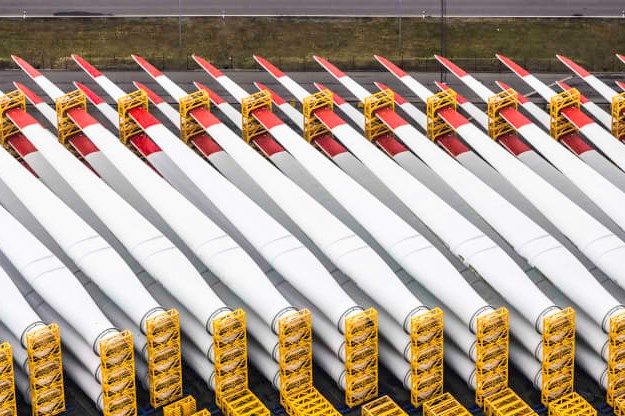Ørsted to recover, reuse or recycle wind turbine blades
Offshore wind farm developer reports it will temporarily store decommissioned composite blades, should recycling solutions take longer than anticipated.

Photo Credit: Ørsted A/S
Ørsted A/S (Fredericia, Denmark), the world’s largest offshore wind farm developer, reported on June 3 that it would “reuse, recycle or recover” all turbine blades in its worldwide portfolio of wind farms once they’re decommissioned. According to the company, it has “a clear responsibility to help find solutions to the challenge of recycling blades.” Earlier this year, Ørsted was reported as being part of the DecomBlades consortium seeking to investigate and develop solutions to recycle the composite material in wind turbine blades.
Ørsted notes that the issue of what to do with wind turbine blades when they’re no longer needed is a headache for the industry. This is because the composite materials blades are made from can be difficult to recycle, with Ørsted pointing out that “most” blades, once decommissioned, are landfilled.
Further, as governments around the world attempt to ramp up their renewable energy capacity, the number of wind turbines globally looks set to increase. For example, the European Commission, the EU’s executive arm, said that in the offshore sector alone it wants capacity to hit at least 60 gigawatts (GW) by 2030 and 300 GW by the middle of the century. The U.K., which left the EU at the end of January 2020, wants its offshore wind capacity to reach 40 GW by 2030. The U.S. is also looking to significantly increase its offshore wind capacity this decade.
Given the above, says Ørsted, the problem of what to do with turbine blades will become even more pressing going forward. For its part, the company explains it will “temporarily store” decommissioned blades if finding a solution to recycling them takes “longer to solve than anticipated.”
A number of companies involved in the sector have attempted to find solutions to the issue in recent years. In January 2020, wind energy giant Vestas (Aarhus, Denmark) said it was aiming to produce “zero-waste” wind turbines by the year 2040.
Last December, GE Renewable Energy (Paris, France) and Veolia North America (Chicago, Ill., U.S.) signed a “multi-year agreement” to recycle blades removed from onshore wind turbines in the U.S.
More recently, it was announced that a collaboration between academia and industry would focus on the recycling of glass fiber products, a move that could eventually help to reduce the waste produced by wind turbine blades.
Related Content
-
Composites end markets: Energy (2024)
Composites are used widely in oil/gas, wind and other renewable energy applications. Despite market challenges, growth potential and innovation for composites continue.
-
JEC World 2023 highlights: Recyclable resins, renewable energy solutions, award-winning automotive
CW technical editor Hannah Mason recaps some of the technology on display at JEC World, including natural, bio-based or recyclable materials solutions, innovative automotive and renewable energy components and more.
-
Drag-based wind turbine design for higher energy capture
Claiming significantly higher power generation capacity than traditional blades, Xenecore aims to scale up its current monocoque, fan-shaped wind blades, made via compression molded carbon fiber/epoxy with I-beam ribs and microsphere structural foam.















